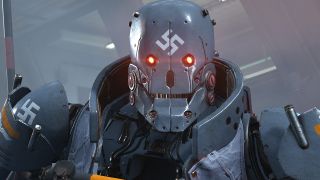The making of Titanfall 2: How building blocks, buddy robots, and Half-Life led to one of the freshest FPS in years
"How do you make a shooter that's not Call of Duty?" That was the question. The answer was something no-one saw coming.
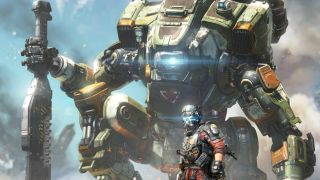
Steve Fukuda, game director of the Titanfall series, has worked on some of the biggest-hitting set-pieces in all games. Landing on Omaha Beach in Medal Of Honor: Allied Assault, reclaiming Stalingrad in Call of Duty 2, a nuclear explosion in Call of Duty 4, No Russian in Modern Warfare 2. “But, looking at Titanfall, we realised that we didn’t have what I call the ‘movie’ of the game.”
Whether Black Hawk Down or Saving Private Ryan, Fukuda’s previous work was built on grand cinematic touchstones. Titanfall was instead founded on its deceptively deep multiplayer, which featured such novel ideas as AI mobs and the interplay between hyper-manoeuvrable pilots and hulking mechs. It was fast, tactical and dynamic, and also a model of the reason why multiplayer-heavy games, like the Call of Duty series, feature expensive single-player campaigns. Titanfall lacked moments to breathlessly share around an office watercooler or be chewed over in op-eds.
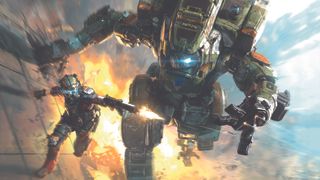
This wasn’t the only reason that, despite its strong sales, it quickly shed active players. But it was a significant one, and the first thing on Fukuda’s mind when, in the autumn of 2014, he began to think about what shape a Titanfall sequel should take.
Building a single-player campaign might sound a straightforward task for Respawn’s Call of Duty veterans, but as Fukuda tells us, “One of the big challenges was also a certain degree of mental inertia of having been used to making the same kind of shooter campaign for many years. That was an internal obstacle to overcome. How do you make a shooter that’s not Call of Duty?”
The answer was in what amounted to a game jam, with members of the campaign development team being freed to experiment with design and technology. As a whole, the studio shucked away an internal expectation that the single-player campaign had to closely follow the rules of the multiplayer one, and began to tinker with ideas and build prototypes that might be stitched together and form the ‘movie’ of the game that Fukuda and co. thought so essential.

Those first months of Titanfall 2’s development had few boundaries other than the object to use general Titanfall mechanics and its engine in interesting ways. “Some people did things with titans; some people did things with pilot mobility and wall-running; some people did things with puzzles,” says Fukuda.
The prototypes the team were making were known internally as ‘action blocks’: discrete prototypes which would be eventually stitched together into a tightly controlled firework of a shooter campaign which throws idea after idea with almost Nintendo brevity; from time travel to transforming levels, leaping between spaceship troop carriers to Titan assaults.
Sign up to the GamesRadar+ Newsletter
Weekly digests, tales from the communities you love, and more
“You can imagine there was a lot of friendly competition in there,” says senior game designer Steven DeRose. “I remember that after a set of action blocks that Mo [Mohammad Alavi] and Chad [Grenier] had made, I was sitting in an office with Mo and Chad comes in and says, ‘No, it was a cool action block. I could’ve made it twice as good.’ Then Mo said the same thing back to him about his.”
From small steps to giant leaps
Platforming was a big focus – all the better to explore the empowering and responsive Pilot mobility that granted the first game its immediate contrast with other shooters. Chad Grenier built a series of puzzles about moving cranes into place so the player could wall-run along the panels that hung below them. Sean Slayback built a set of action blocks that had Titans throwing the player between locations. “I don’t think there was much finessing and iteration,” says Fukuda. “You’d throw an idea out, then everyone says, ‘Cool,’ or, ’It could use work’. We wouldn’t sit there noodling about it; we’d just move on to the next one.”
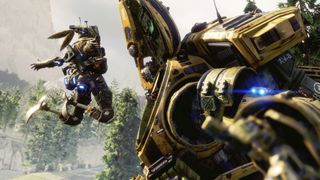
But the intention was to discover good ideas and to look at them in concert in order to understand what shape the campaign would take. “Over a period of time we got to a point where we got a touchstone for single-player,” says Fukuda. “We called it ‘211’. Two parts Pilot combat, one part Pilot mobility and puzzling, one part Titan combat. So ‘211’ was this phrase we had to describe what a Titanfall single-player level would be and that was a big moment. We’d finally cracked what the spirit of single-player was from a design standpoint.”
Then, the team started to figure out how to piece blocks together in a coherent way. Grenier’s crane puzzle became a chunk of the Beacon level. Slayback’s Pilot-throwing was chopped down, because the team found it difficult to implement into something interactive, into several cutscene sequences. But it was all very much founded on design, with the goal of building a game out of blocks of play.
As for the basis on which these components would be knitted together, the team was aiming, very explicitly, to make Half-Life. “That was actually said,” Fukuda says. “The reason for that was primarily a matter of trying to create mystery, in the sense that players wouldn’t be able to guess what was going to happen next. That would be a big driver of players staying with the campaign, and it was also a byproduct of the fact that we approached this very gameplay-first. Almost to the exclusion of story, to be honest.”
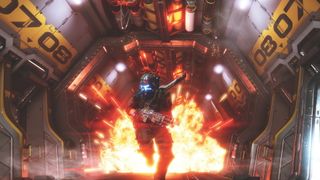
Most Titanfall 2 players would be hard-pressed to remember the details of its plot, which is mostly trying to keep up with making sense of the divergent ideas and set-pieces you face. Take, for example, the time travel that appears in Titanfall 2’s landmark level, Effect and Cause. For this section only, you are given the ability to instantaneously switch between time periods at an enemy facility; in the past it’s filled with scientists and soldiers and is gleaming new, and in the present it lies in ruins, and Respawn takes every opportunity to play with it, posing puzzles and combat challenges and little narrative details that make you realise that you’re actually causing all the destruction.
It originated in an action block made by designer Jake Keating, and it immediately stood out to the team as something that should go into the game. Some members, in fact, felt that its mechanic should extend across the entire game. But rather than wring all they could from the mechanic, Keating and his group instead honed and cut it into the succinct and taut form it takes in the final thing. “Which is probably part of why people really like it,” says lead programmer John Haggerty. “Stretching it out might have been a bad thing anyway.
The cost of a great idea
And it was expensive to build, though not so much in terms of technology. “It’s a funny level because people often ask us how we do that, switching back and forth between timelines,” says Fukuda. “The answer is, well, we just made two buildings, one on top of the other, and teleport you up and down between them. It’s super simple.” But that meant that every location needed to be built twice, effectively doubling the workload.
Still, it was clearly exactly the kind of banner level that the team was looking for. “We wanted to showcase it to the point that we warped the story completely to accommodate it,” Fukuda continues. “The whole ending with the spinning rings, it’s all because we wanted to make it fit in the narrative. It was a big change.”
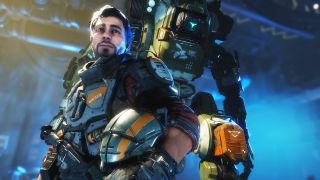
Instead of the overall plot, what sticks is the relationship the story strikes between the player and BT-7274, the Titan you pilot over its course. That it’d be a buddy story was the one element that was set from the start, with the arc taking players from the role of the prototypical shooter grunt to, by its end, a light-footed and multi-skilled Pilot. The idea was that the progress would mirror the experience of players coming into Titanfall 2 from playing Call of Duty. “That was the in-joke about who you are,” says Fukuda.
BT is primarily a construction of animation, since its voice only came in right at the end of the game’s development. Even its name betrays BT’s developmental roots: “We called the Titan the ‘Buddy Titan’,” says Haggerty. The rest of the studio hated the name; Fukuda only managed to keep it by refusing to change until it was clear it didn’t present any problems, by which time everyone had acclimatised to it.
Animator Shawn Lee Wilson would normally work to voice performances, but without one to animate to he had to bounce ideas off Fukuda and construct BT as he went along, watching Akira Kurosawa films and tracing lines between Clint Eastwood and Sam Elliott cowboy roles to figure out its physical character, and expressing it entirely through its physical performance. Lee Wilson took over the studio’s motion-capture room to act out BT’s run, walk and gestures, embodying its great power and grace, steadily narrowing towards setting the strong and reassuring presence it has in the final game.

“It was important that the player felt reassured, because you’re going to be this person stranded behind enemy lines, marooned with this strange robot,” says Fukuda. “There’s a sense that, as the new player to Titanfall, you needed someone you could trust, someone reliable and safe.” In the first iterations of BT’s script, however, it erred towards the bossy. They wanted to avoid Optimus Prime, and they also needed it to perform the role of the player’s main objective-giver.
Part of the solution was to create conversations between player and mech, intended as a way of strengthening their bond with BT without resorting to cutscenes. But they raised some controversy in the studio: if they were making Half-Life, shouldn’t they have a silent protagonist? When the script had BT asking if the player was OK after they’d fallen down a pit, Fukuda realised there was room for a response from the player character.
These moments of dialogue choice are a minor flourish for a game that’s about wall-running across chasms and giant mechs hitting each other with swords. But they give a little space for self expression, and even a gently progressive air among all the bullets, following the same path (if to a very different destination) as games like Kentucky Route Zero. Accidentally. “Actually, I played Firewatch long after the game shipped and I didn’t know about it at the time, but, ‘Oh, these guys did it already!’”, Fukuda says.
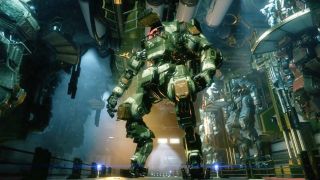
Much of the flexibility with which the pieces of Titanfall 2’s campaign came together is a direct result of its engine, which allows designers a great deal of power to script their own levels. The engine is Source, which powers Half-Life 2 and Portal 2, but was heavily modded to build the original Titanfall. During the making of the first game, Haggerty and his team had entirely broken the original Valve code that saves and loads level progress. Back then it wasn’t necessary for a multiplayer game, but to reinstate it for the sequel’s campaign was a huge hurdle.
The scripting system was entirely made by Respawn, too, and it enabled designers to construct even Titanfall 2’s most technical-seeming moments. Effect And Cause was not the work of programmers but of its designer, Jake Keating. Looking back at the way Titanfall 2’s campaign is constructed of hundreds of little blocks of play, it’s clear that it’s enabled by the fact its designers could quickly produce their own divergent takes on what mechs and Pilots can do.
There’s one sequence during Into The Abyss, in which prefabricated chunks of buildings and ground construct themselves into the level around you for a single encounter, before it whisks you on to something completely new. It embodies the spirit of Titanfall 2’s campaign: it’s a game about hyperactive movement and thundering power, built from one dazzling set-piece after another.
This article originally appeared in Edge magazine. For more great coverage, you can subscribe here.

Most Popular



